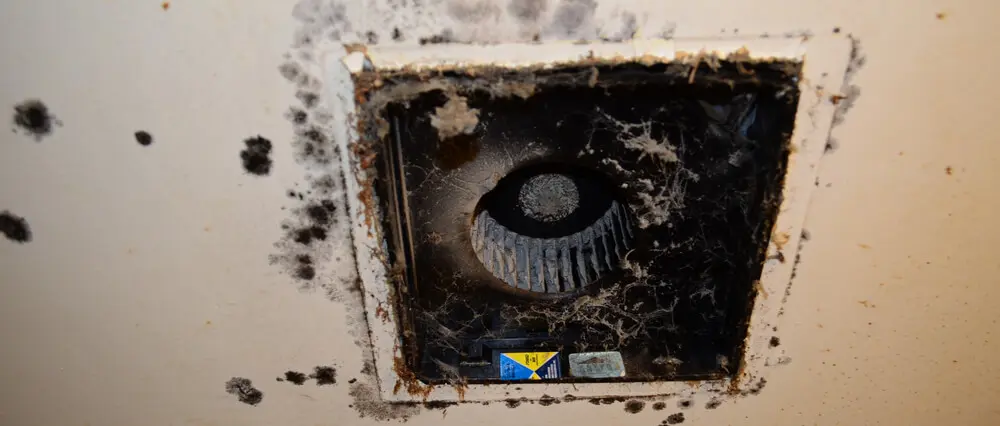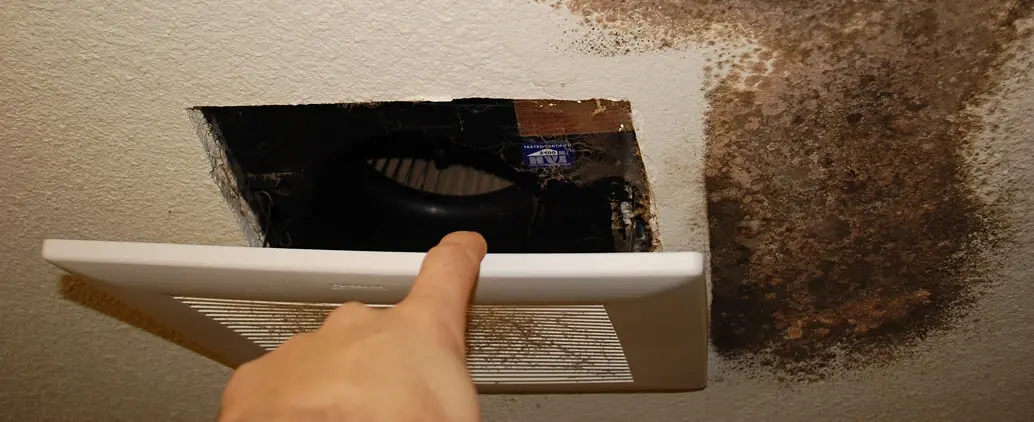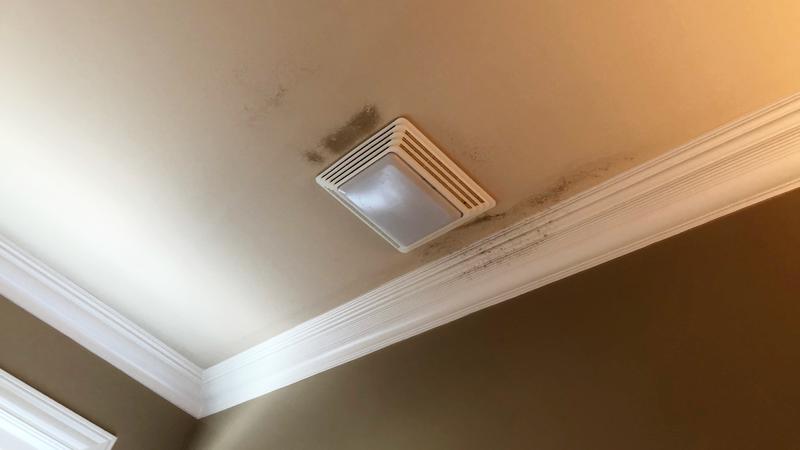Real Solutions to Permanently Eliminate Bathroom Mold & Mildew
Bathroom exhaust fans perform a critical, though often neglected, function. Their first responsibility it to exhaust warm, damp air created during shower/bath usage. Second, they are called on to exhaust bathroom odors. Both of these depend upon a simple process of drawing air from inside the bathroom and expelling it to the outside. Fans play an important role in diminishing bathroom mold growth.
Where do bathroom fans go wrong?
- Non-existent. Occasionally I’ll find homes with no exhaust fan whatsoever. Often the homeowner’s solution is to open a window and hope for a decent breeze. The problem is much more common in pre-1950’s homes. Most building code requirements have called for bathroom fan installations for decades.
- Under-powered. Many bathroom exhaust fans are underpowered to begin with. The remainder often loses power and velocity over time due to worn out motors or clogged assemblies. Even in million $+ homes, the bathroom fans are nearly always cheap, hardware store variety.
- Dumb Installation. Designing a proper bathroom exhaust fan isn’t rocket science. However, there are design flaws that can dramatically reduce their effectiveness. The most common problem is the absence of ducting. While this doesn’t diminish the fan’s ability to exhaust air from the bathroom, it certainly can cause major mold and wood decay in the adjacent framing. Other problems include long and convoluted ducting paths, which can greatly reduce the fan’s ability to move enough air.
Results of bathroom fan failure:
Failing bathroom fans can lead to a number of comfort issues, however the most concerning problem is the likelihood of mold growth. This occurs when the bath fan fails to properly exhaust the excessive moisture created by shower usage. Lacking an appropriate escape path, the moisture soon condenses on the ceiling and walls. This creates the speckling illustrated in the photo below. Thankfully, because the mold growth is due to condensation, the problem is confined to the warm side of the ceiling or walls. Even in fairly severe cases, the backside of the sheetrock will remain completely mold free. This occurs because the wall or ceiling becomes the first condensing surface, effectively trapping the moisture before it can escape to through the wall. Now technically, a small amount of moisture migrates through the sheetrock, but this moisture will easily travel through the insulation on the other side.

Bath Fan Failure Leads to Mold Growth
Determining the correct size / CFM of a bathroom exhaust fan.
According to the Home Ventilating Institute, a correctly sized bathroom fan should achieve a minimum of 8 air changes per hour. This means that within 60 minutes, the entire volume of air within the bathroom will be replaced 8 times. Of course, this doesn’t apply to bathrooms with saunas hot tubs or other exotic, moisture producing devices. The vast majority of bathrooms will need a fan capable of producing 60-120 CFM.

Below is an example of a typical size bathroom and the associated calculations:

Fan Controls: Constant flow vs. timer vs. switch
The best fan in the world won’t do much good if it isn’t on when it needs to be. In the past, the answer was straightforward: either a simple switch or an old fashioned dial timer. Neither work very well, as people tend to turn off the switch after showering or the timers just failed. Both result in inadequate air flow and mold problems.
Today, we have far better options. Roughly these fall into the categories of continuous flow or digital timer. As the name implies, a continuous flow bath fan runs all the time at a low CFM (typically 30-40), but ramps up to full speed when the bathroom is in use. Panasonic models do this the best and can be set to run an additional 30-60 minutes after the occupant leaves the bathroom. This allows the fan to exhaust the residual moisture built up during shower usage.
Digital timers are simply an updated version of the dial timer. Because they are digital rather than mechanical, they tend to last far longer. They work well in situations where the occupants can be trusted to operate the timer correctly. With children or tenants, the constant flow models are superior.
*Heads up – I earn a small commission on sales through Amazon links. This helps cover the expense of running the website (and answering your questions!)
Got a question? Ask it here and we'll post the answer below
Hi... we have brown and black stuff falling from our bathroom fan. I am in there more than the rest of the family and developed a fungal infection of the skin and scalp a couple of months ago, as summer came. My 16 year old son though had issues with his asthma and dizzy/nausea/vomiting since we moved here. I have also had more sinus issues than l haven't since we moved in. It seems like it's been a long road of being unhealthy for two healthy people... my son plays three sports each yr. He's really for and never sick except for his breathing and these spells now. We rent and I don't where to go from here. Please help!
I am sorry to hear about your predicament. First, vacuum out the existing bath fan. 2nd, attempt to convince your landlord to replace the bathroom fan, preferably with a constant flow unit like a Panasonic WhisperGreen. If they balk at the price, perhaps offer to split the cost. If replacing the fan isn’t an option, I would simply run the fan 24/7. This will dramatically lower the humidity in the home during the winter months (unless you live in a very warm/humid climate like Florida). Lastly, purchase a relative humidity gauge and make sure the interior of the home stays below 50% during the winter months and below 60% in the summer.
We are experiencing mold in four out of six bathrooms next to the exhaust fan. The worst one does not seem to be a humidity issue because that bathroom is not used as a shower. as you can probably see in the photo it has spread to the crown molding in this bathroom. Three of the bathrooms are on the top floor with attic above and one bathroom is on the main level of the home with finished space above. There are two bathrooms unaffected. The home was built in 2005 and we have lived here since 2011. Seems unlikely that all of the fans would stop operating within 2–4 months of each other?? The only notable thing that we have wondered about is that we had a squirrel infestation and had the home sealed between the home and roof line. Any ideas? Thank you so much.
This is a bit strange. Typically this kind of growth is due to poor insulation in the ceiling cavity around the bath fan. However, it’s a bit unusual to see the growth extending to the adjacent crown molding. This can occur when the backdraft flapper on the bath fan is not working correctly. This allows cold air to drop down the exhaust duct, cooling the surrounding sheetrock. Over time, this can lead to condensation and mold growth.
- Check the bath fan flapper. If it’s missing, you can add an in-line flapper on the 4″ exhaust duct. Note – do not install a flapper if you implement step 4.
- Check insulation levels around the bath fans.
- Air seal where the fan assembly meets the ceiling/sheetrock with expanding spray foam. Be careful not to let the foam expand into the room below.
- Replace one of the exhaust fans on the upper floor with a constant flow unit such as the Panasonic WhisperGreen.


